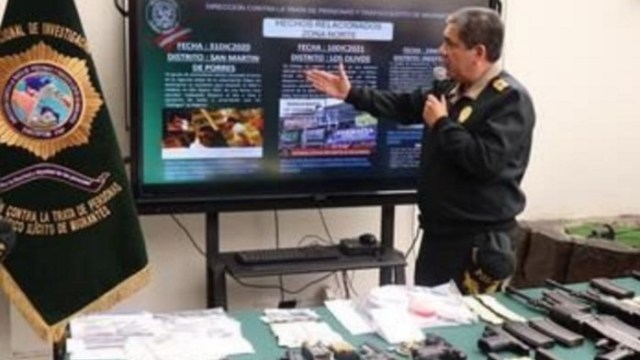
General Ulises Guillén, director of the Peruvian National Police (PNP) Anti-Trafficking and Migrant Smuggling Directorate, has led an effort by Peruvian intelligence to dismantle the Gallegos, the strongest armed wing of the Tren de Aragua, Venezuela’s most powerful transnational criminal organization.
By Insight Crime
Dec 06, 2022
Peruvian authorities captured 30 members of the Gallegos, including leader José Ángel Ortega Padrón, alias “Armando,” on November 10. According to Ulises Guillén, the arrests mark the first stage of a campaign against the gang, which has gained a strong foothold in the country and is involved in extortion, human trafficking, sexual exploitation and murder.
InSight Crime spoke with Ulises Guillén about how the Tren de Aragua has become an international threat and serious security concern for neighboring countries like Perú. The gang is operated out of Tocorón Prison in Venezuela’s Aragua state, where leader Héctor Rusthenford Guerrero Flores, alias “Niño Guerrero,” is currently serving time. Despite his imprisonment, Niño Guerrero has overseen the construction of an international criminal empire.
InSight Crime (IC): Why did the PNP carry out the operation against the Gallegos?
General Ulises Guillén (GUG): We decided to act after the murders of two female Ecuadorian sex workers in downtown Lima on February 19 this year. That these women were murdered indicated that a criminal organization, not just a gang, was involved. While there has always been street prostitution and prostitution in clandestine premises in the country, this level of violence has never been associated with it. No one was murdered because of prostitution before.
IC: How did you confirm that the Gallegos works under the Tren de Aragua?
GUG: We confirmed the connection through an intelligence investigation we carried out together with the Attorney General’s Office with information from intercepted messages from the criminal in WhatsApp groups. We also found out that the Tren de Aragua has built criminal networks and connections in countries with higher rates of Venezuelan migration. The Gallegos report to a leader we know only as “HD,” who in turn reports to “Niño” Guerrero.
IC: What illegal economies are the Gallegos linked to in Perú?
GUG: The Gallegos are involved in street prostitution and extortion, mainly in downtown Lima. They have also been linked to human trafficking, sexual exploitation, and homicide.
The group has expanded from the downtown area into other Lima neighborhoods. To date, we have identified 13 areas of the capital where the group is present.
IC: How strong is the Tren de Aragua in Peru?
GUG: We found that the Tren de Aragua works as a franchise. Many Venezuelan criminals who have emigrated to other countries are part of the group’s criminal network. These criminals use the group’s name and report to the headquarters in Venezuela.
IC: What challenges does Perú’s prison system face in holding members of the Tren de Aragua?
GUG: Our job doesn’t usually end with the capture or dismantling of a criminal organization — we have to work cooperatively with other state institutions [like the prison system].
Perú tries to block any calls entering or leaving Peruvian prisons. Prisons in the country’s interior don’t receive strong cell connections due to their location, so prisoners there have trouble contacting anyone outside. Those prisons are therefore safer, and the most dangerous criminals are sent to them.
The impact of this strategy is limited because there aren’t many prisons in the country’s interior, while the majority of the prison population is concentrated in Lima in overcrowded prisons.
IC: Have you been able to determine how those profits generated in Peru reach Tocorón Prison in Venezuela?
GUG: We have identified some bank accounts and are following up on investigations into them.
It is most likely that profits reach Tocorón via human couriers. Peru’s borders are not well guarded, so moving money out of the country is relatively easy.
IC: You have said it is unusual for Peruvian groups to use rifles and other heavy weapons. Do you know how these types of arms get into the country?
GUG: They may enter through the country’s northern border [with Ecuador and Colombia]. In other neighboring countries, there are armed organizations that make use of heavy weaponry. We don’t rule out that the guns in Peru could have come from those countries.
IC: What will happen to captured Venezuelan members of the Gallegos? Will they be extradited?
GUG: No, not yet. According to our legislation, every person who commits crimes in our country is tried and sentenced here. They will be extradited once they have served their sentences.
…
Read More: Insight Crime – How Perú is Tackling The Danger of Venezuela’s Tren de Aragua
…

